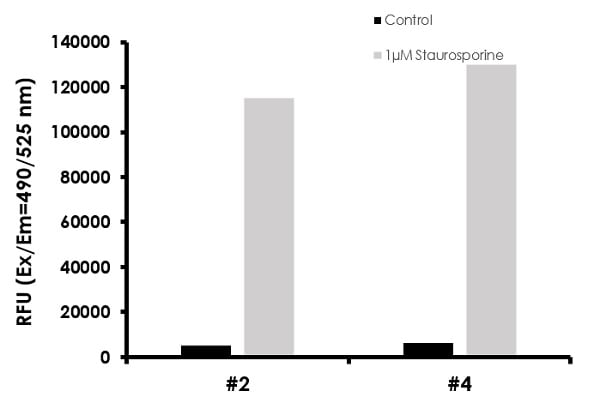Caspase-3, Caspase-8 and Caspase-9 Multiplex Activity Assay Kit (Fluorometric) (ab219915)
Key features and details
- Assay type: Semi-quantitative
- Detection method: Fluorescent
- Platform: Microplate reader
- Sample type: Adherent cells, Suspension cells
Overview
-
Product name
Caspase-3, Caspase-8 and Caspase-9 Multiplex Activity Assay Kit (Fluorometric) -
Detection method
Fluorescent -
Sample type
Adherent cells, Suspension cells -
Assay type
Semi-quantitative -
Product overview
Caspase 3, Caspase 8 and Caspase 9 Multiplex Activity Assay Kit (Fluorometric) (ab219915) provides a simple and convenient tool to monitor caspase 3, caspase 8 and caspase 9 activity in cells that are undergoing apoptosis.
This product is designed to simultaneously monitor key caspases involved in apoptosis: the initiator caspases caspase 8 and caspase 9, and the executioner Caspase 3 (which share the same substrate). The kit uses DEVD-ProRed™, IETD-R110 and LEHD-AMC as fluorogenic indicators for Caspase 3, caspase 8 and caspase 9 activity respectively. Upon caspase cleavage, three distinct fluorophores are released: ProRed™ (red fluorescence), R110 (green fluorescence) and AMC (blue fluorescence), which can be readily monitored in a single assay due to their nice spectral separation.
This product has been optimized for use in a microplate reader in 96-well plate, providing enough reagent to perform 100 tests for each caspase.
-
Platform
Microplate reader
Properties
-
Storage instructions
Store at -20°C. Please refer to protocols. -
Components 100 tests 200X Caspase 3 Substrate 1 x 50µl 200X Caspase 8 Substrate 1 x 50µl 200X Caspase 9 Substrate 1 x 50µl Assay Buffer 1 x 30ml -
Research areas
-
Cellular localization
Caspase 3: Cytoplasmic Caspase 8: Cytoplasmic
Images
-
Caspase 3, Caspase 8 and Caspase 9 Multiplex Activity Assay Kit (Fluorometric) (ab219915). Detection of Caspase activity in Jurkat cells graphs shown Caspase 9 activity. Jurkat cells were seeded on the same day at 2 x 105 cells/well in a Costar black wall/clear bottom 96-well plate. Cells were either left untreated (black bar) or treated with 1 µM staurosporine for 4 hours (gray bar). Single-caspase assay loading solution (100 µL/well; #1 for Caspase 3, #2 for caspase 8 or #3 for caspase 9) or Triple-caspase assay loading solution (100 µL/well; #4 for Caspase 3, 8 and 9 together) was added to cells, followed by an incubation at RT for 1 hour. The fluorescence intensity was measured with FlexStation fluorescence microplate reader at the indicated wavelength. Caspase 3, 8 and 9 activities can be detected in a single assay without interferences from other caspases.
-
Caspase 3, Caspase 8 and Caspase 9 Multiplex Activity Assay Kit (Fluorometric) (ab219915). Detection of Caspase activity in Jurkat cells graphs shown Caspase 8 activity. Jurkat cells were seeded on the same day at 2 x 105 cells/well in a Costar black wall/clear bottom 96-well plate. Cells were either left untreated (black bar) or treated with 1 µM staurosporine for 4 hours (gray bar). Single-caspase assay loading solution (100 µL/well; #1 for Caspase 3, #2 for caspase 8 or #3 for caspase 9) or Triple-caspase assay loading solution (100 µL/well; #4 for Caspase 3, 8 and 9 together) was added to cells, followed by an incubation at RT for 1 hour. The fluorescence intensity was measured with FlexStation fluorescence microplate reader at the indicated wavelength. Caspase 3, 8 and 9 activities can be detected in a single assay without interferences from other caspases.
-
Caspase 3, Caspase 8 and Caspase 9 Multiplex Activity Assay Kit (Fluorometric) (ab219915). Detection of Caspase activity in Jurkat cells graphs shown Caspase 3 activity. Jurkat cells were seeded on the same day at 2 x 105 cells/well in a Costar black wall/clear bottom 96-well plate. Cells were either left untreated (black bar) or treated with 1 µM staurosporine for 4 hours (gray bar). Single-caspase assay loading solution (100 µL/well; #1 for Caspase 3, #2 for caspase 8 or #3 for caspase 9) or Triple-caspase assay loading solution (100 µL/well; #4 for Caspase 3, 8 and 9 together) was added to cells, followed by an incubation at RT for 1 hour. The fluorescence intensity was measured with FlexStation fluorescence microplate reader at the indicated wavelength. Caspase 3, 8 and 9 activities can be detected in a single assay without interferences from other caspases.









